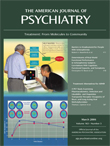To the Editor:
Drs. Brady and Sinha described a neurobiological and behavioral model of comorbid substance use and psychiatric disorders in which substance use by vulnerable individuals may be both an attempt to medicate preexisting chronic stress and a cause of continuing stress. Extraordinarily high nicotine use in schizophrenia, however, could relate to nicotine’s ability to attenuate sensory gating deficits indicative of disordered nicotinic transmission, as the authors suggested. Indeed, alpha-7 nicotinic receptors (α7-nAChRs) are reduced in the brain by approximately 50% (1) and in peripheral blood by up to 90% (2) in schizophrenia patients, regardless of smoking history. We hypothesize that low α7-nAChRs also impair stress regulation in schizophrenia. A possible mechanism involves anandamide, an endogenous cannabinoid that dampens hypothalamic stress activation (3). However, anandamide formation, at least in rat cortical neurons, requires α7-nAChR activation (4). Evidence that nicotine or exogenous cannabinoids can reverse attentional and stress-related cognitive deficits in rodents and humans (5–7) suggests that these agents target common pathways.
Anandamide’s stress regulation may also depend on the availability of its precursor, arachidonic acid, which is low in some schizophrenia patients. In a preliminary study, we found that former cannabis users with schizophrenia, but not cannabis-naive patients, show an inverse relationship between stress and arachidonic acid and other fatty acids that support anandamide (8). Currently, we are exploring interactions between fatty acids, endocannabinoids, nicotinic deficits, and stress (FENDS) in schizophrenia.
Drs. Brady and Sinha suggested that nicotinic receptors are potential therapeutic targets. In addition, cannabinoid agonists and antagonists, fatty acid supplementation, dietary modification, and cognitive behavior reframing of responses to stressors could potentially ameliorate the putative FENDS interactions in schizophrenia.
1. Leonard S, Breese C, Adams C, Benhammou K, Gault J, Stevens K, Lee M, Adler L, Olincy A, Ross R, Freedman R: Smoking and schizophrenia: abnormal nicotinic receptor expression. Eur J Pharmacol 2000; 393:237–242Crossref, Medline, Google Scholar
2. Perl O, Ilani T, Strous RD, Lapidus R, Fuchs S: The alpha7 nicotinic acetylcholine receptor in schizophrenia: decreased mRNA levels in peripheral blood lymphocytes. FASEB J 2003; 17:1948–1950Crossref, Medline, Google Scholar
3. Di S, Malcher-Lopes R, Halmos KC, Tasker JG: Nongenomic glucocorticoid inhibition via endocannabinoid release in the hypothalamus: a fast feedback mechanism. J Neurosci 2003; 23:4850–4857Crossref, Medline, Google Scholar
4. Stella N, Piomelli D: Receptor-dependent formation of endogenous cannabinoids in cortical neurons. Eur J Pharmacol 2001; 425:189–196Crossref, Medline, Google Scholar
5. Hill MN, Patel S, Carrier EJ, Rademacher DJ, Ormerod BK, Hillard CJ, Gorzalka BB: Downregulation of endocannabinoid signaling in the hippocampus following chronic unpredictable stress. Neuropsychopharmacology 2005; 30:508–515Crossref, Medline, Google Scholar
6. Ingram N, Martin S, Wang J, van der Laan S, Loiacono R, van den Buuse M: Interaction of corticosterone and nicotine in regulation of prepulse inhibition in mice. Neuropharmacology 2005; 48:80–92Crossref, Medline, Google Scholar
7. Solowij N: Cannabis and Cognitive Functioning. Cambridge, UK, Cambridge University Press, 1998Google Scholar
8. Monterrubio S, Solowij N, Meyer BJ, Turner N: Fatty acid relationships in former cannabis users with schizophrenia. Prog Neuropsychopharmacol Biol Psychiatry (in press)Google Scholar



